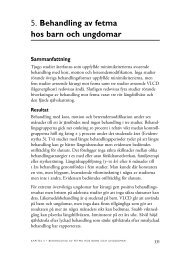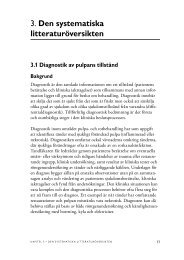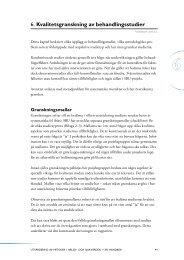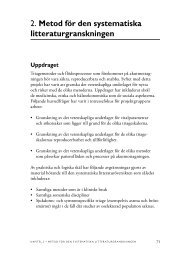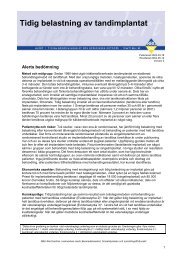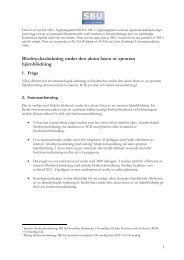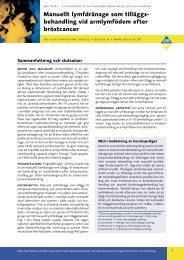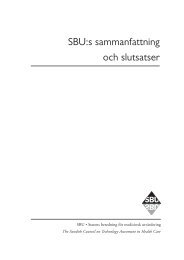Fulltext - SBU
Fulltext - SBU
Fulltext - SBU
Create successful ePaper yourself
Turn your PDF publications into a flip-book with our unique Google optimized e-Paper software.
19. Karjalainen S, Söderling E, Sewón L,<br />
Lapinleimu H, Simell O. A prospective<br />
study on sucrose consumption, visible<br />
plaque and caries in children from 3 to<br />
6 years of age. Community Dent Oral<br />
Epidemiol 2001;29:136-42.<br />
20. Alaluusua S, Malmivirta R. Early<br />
plaque accumulation – a sign for caries risk<br />
in young children. Community Dent Oral<br />
Epidemiol 1994;22:273-6.<br />
21. Demers M, Brodeur JM, Mouton C,<br />
Simard PL, Trahan L, Veilleux G. A multivariate<br />
model to predict caries increment in<br />
Montreal children aged 5 years. Community<br />
Dent Health 1992;9:273-81.<br />
22. Holbrook WP, de Soet JJ, de Graaff J.<br />
Prediction of dental caries in pre-school<br />
children. Caries Res 1993;27:424-30.<br />
23. Schröder U, Widenheim J, Peyron M,<br />
Hägg E. Prediction of caries in 1 1/2-yearold<br />
children. Swed Dent J 1994;18:95-104.<br />
24. Sullivan Å, Granath L, Widenheim J.<br />
Correlation between child caries incidence<br />
and S. mutans/lactobacilli in saliva after correction<br />
for confounding factors. Community<br />
Dent Oral Epidemiol 1989;17:240-4.<br />
25. Thibodeau EA, O’Sullivan DM.<br />
Salivary mutans streptococci and incidence<br />
of caries in preschool children. Caries Res<br />
1995;29:148-53.<br />
26. Twetman S, Petersson LG. Prediction<br />
of caries in pre-school children in relation<br />
to fluoride exposure. Eur J Oral Sci<br />
1996;104:523-8.<br />
27. Wendt LK, Hallonsten AL, Koch G,<br />
Birkhed D. Analysis of caries-related factors<br />
in infants and toddlers living in Sweden.<br />
Acta Odontol Scand 1996;54:131-7.<br />
28. Ollila P, Niemelä M, Uhari M, Larmas<br />
M. Prolonged pacifier-sucking and use of a<br />
nursing bottle at night: possible risk factors<br />
for dental caries in children. Acta Odontol<br />
Scand 1998;56:233-7.<br />
29. Burt BA, Pai S. Does low birthweight<br />
increase the risk of caries?<br />
A systematic review. J Dent Educ<br />
2001;65:1024-7.<br />
30. Raadal M, Espelid I. Caries prevalence<br />
in primary teeth as a predictor of<br />
early fissure caries in permanent first<br />
molars. Community Dent Oral Epidemiol<br />
1992;20:30-4.<br />
31. Skeie MS, Raadal M, Strand GV,<br />
Espelid I. The relationship between caries<br />
in the primary dentition at 5 years of age<br />
and permanent dentition at 10 years of age<br />
– a longitudinal study. Int J Paediatr Dent<br />
2006;16:152-60.<br />
32. Stewart PW, Stamm JW. Classification<br />
tree prediction models for dental caries<br />
from clinical, microbiological, and interview<br />
data. J Dent Res 1991;70:1239-51.<br />
33. ter Pelkwijk A, van Palenstein Helderman<br />
WH, van Dijk JW. Caries experience in the<br />
deciduous dentition as predictor for caries<br />
in the permanent dentition. Caries Res<br />
1990;24:65-71.<br />
34. Vanobbergen J, Martens L, Lesaffre<br />
E, Bogaerts K, Declerck D. The value of a<br />
baseline caries risk assessment model in the<br />
primary dentition for the prediction of caries<br />
incidence in the permanent dentition.<br />
Caries Res 2001;35:442-50.<br />
35. Zhang Q, van Palenstein Helderman<br />
WH. Caries experience variables as indicators<br />
in caries risk assessment in 6–7-year-old<br />
Chinese children. J Dent 2006;34:676-81.<br />
310<br />
Karies – diagnostik, riskbedömning och icke-invasiv behandling



